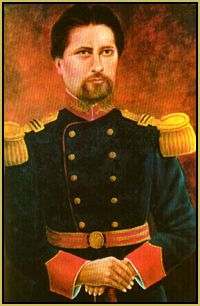Pedro Ruiz Gallo facts for kids
Quick facts for kids
Pedro Ruiz Gallo
|
|
|---|---|

Oil painting in the Aeronautical Museum of Peru
|
|
| Born | June 24, 1838 Etén, Chiclayo, Peru |
| Died | April 24, 1880 (aged 41) Callao, Peru |
| Years of service | 1848–1880 |
| Battles/wars | |
Pedro Ruiz Gallo (born in Etén on June 24, 1838 – died in Callao on April 24, 1880) was a truly amazing Peruvian. He was a polymath, which means he was skilled in many different areas! Pedro was a soldier and an inventor, but he also worked as a watchmaker, mechanic, musician, painter, researcher, doctor, and explorer.
In Peru, he's considered one of the first people to think about modern aeronautics (the science of flight) and is honored as the patron (a special protector) of the Peruvian Army's engineering branch. He's most famous for creating the incredible monumental clock that used to be in the Parque de la Exposición in Lima. Sadly, this clock was taken by Chilean troops during the War of the Pacific.
Contents
Early Life and Big Dreams
Pedro was born in a town called Villa de Eten in 1838. His parents were Pedro Manuel Ruiz, a Spanish colonel, and Juliana Gallo. Life became tough for Pedro when he was very young. He lost his father, and then when he was just 11 years old, his mother also passed away.
This sad situation meant he had to leave his small hometown and move to the city of Chiclayo. There, he started working as an assistant to a watchmaker. This job sparked a lifelong interest in mechanics and how things work, especially clocks!
A Soldier and Explorer
Even though Pedro loved mechanics, he also felt a strong desire to serve his country in the military. So, at the age of 15, he moved to Lima and joined the Peruvian Army in 1854. Because he was so smart and talented, he quickly moved up the ranks. By 1855, he was already a captain!
He served as an assistant in the department of Amazonas. During this time, he went on many explorations and studies in the Peruvian jungle, which was still largely unknown. He even explored a dangerous river gorge called the Pongo de Manseriche. He also mapped the paths of the Marañón River and one of its smaller rivers, the Cahuapanas River.
Discovering a Smallpox Vaccine
While he was in the jungle, Pedro also got involved in medicine. He made an important discovery: he found a way to use fluid from cows to create an effective vaccine against smallpox, a very serious disease at the time. This was a huge step forward for public health! During his time in Chachapoyas, he also built a public clock and gave it to the main church in the city.
Fighting for Peru's Freedom
In 1865, Pedro was promoted to major. That same year, a revolution began, led by General Mariano Ignacio Prado. This revolution eventually led to the war against Spain. Pedro joined the army that marched to Lima and removed President Juan Antonio Pezet from power.
After that, he fought bravely in the combat of May 2 against the Spanish fleet. For his courage in this battle, he was promoted again, this time to lieutenant colonel.
The Amazing Great Clock of Lima
Once the war with Spain ended and their ships left South American waters, Pedro Ruiz Gallo could finally focus on his engineering projects. His biggest dream was to build a magnificent clock for the capital city of Peru.
What Was the Great Clock?
He achieved this dream with the help of President José Balta, who supported his work and provided funding. Even though some people criticized his project, Pedro kept working calmly and persistently. Finally, on December 6, 1870, just a few days before the anniversary of the Battle of Ayacucho, his amazing monumental clock was officially opened! It stood proudly in the gardens of the Exhibition in front of the Palace of the same name, and everyone was amazed by it.
For many years, the Pedro Ruiz Gallo clock was one of Lima's most popular attractions.
Dreaming of Flying Machines
Even after successfully completing his greatest work, the now-famous inventor never stopped his scientific studies. He became very interested in aeronautics, the study of flight. In 1878, he published a book called Estudios Generales sobre la Navegación Aérea y Resolución de este importante problema (General Studies on Air Navigation and Resolution of this Important Problem). In this book, he proposed building a flying machine that would use mechanical power to allow humans to fly, just like birds!
However, his work on these flying machines had to stop suddenly. On April 5, 1879, the Chilean government declared war on Peru, starting the conflict known as the War of the Pacific.
Defending Peru in Wartime
In 1879, Pedro Ruiz Gallo returned to his military duties. After Peru lost the Huáscar monitor in the naval combat of Angamos, the Chilean navy gained control of the sea. Pedro then focused his efforts on making torpedoes. These torpedoes were meant to be used against the Chilean ships that were blocking the port of Callao.
A Tragic Accident
Sadly, Pedro Ruiz Gallo died on April 24, 1880. He was working on an experimental torpedo in a workshop in the Ancón balneario (a coastal resort town) north of Callao, when an accident caused an explosion that ended his life.
Where is Pedro Ruiz Gallo Buried?
His body was first buried in the Baquíjano del Callao Cemetery. However, on April 24, 1940, during the government of Manuel Prado Ugarteche, it was ordered that his remains be moved. Today, Pedro Ruiz Gallo rests in the Crypt of the Heroes of the War of the Pacific, a special place for national heroes.
See also
 In Spanish: Pedro Ruiz Gallo para niños
In Spanish: Pedro Ruiz Gallo para niños

